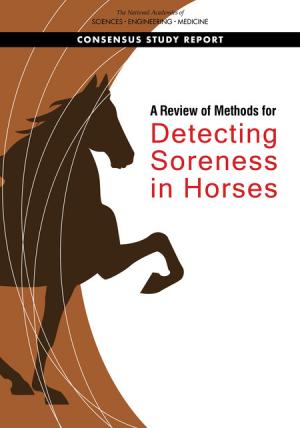The featured 2021 report at the National Academies of Sciences, Engineering, and Medicine is the newly release research report: “A Review of Methods for Detecting Soreness in Horses,” published in January 2021. Description of the study:
During the last century and today, the Tennessee walking horse has been used primarily for pleasure and show competition. Unique and natural to the breed is a smooth four-beat "running walk" gait. In the 1950s the accentuated or exaggerated running walk, known as the "big lick" became popular at high-level competitions. The combination of exaggerated high-action step in front and long stride behind is still considered desirable in today's horse show competitions, and it is often achieved through soring. Soring is the practice of applying a substance or mechanical device to the lower limb of a horse that will create enough pain that the horse will exaggerate its gait to relieve the discomfort. In 1970 Congress put into law the Horse Protection Act (HPA) to specifically address the practice of soring by prohibiting the showing, exhibition, or sale of Tennessee walking horses that are found to be sore. Sadly, soring is still being done even after 50 years of HPA enforcement.
This report reviews the methods for detecting soreness in horses, in hopes of advancing the goal of ultimately eliminating the act of soring in horses and improving the welfare of Tennessee walking horses. A Review of Methods for Detecting Soreness in Horses examines what is known about the quality and consistency of available methods to identify soreness in horses; identifies potential new and emerging methods, approaches, and technologies for detecting hoof and pastern pain and its causes; and identifies research and technology needs to improve the reliability of methods to detect soreness. This independent study will help ensure that HPA inspection protocols are based on sound scientific principles that can be applied with consistency and objectivity.
Read highlights of the report here: https://www.nap.edu/resource/25949/Horse%20Soreness.pdf or read a pre-publication copy of the report here: https://www.nap.edu/read/25949/chapter/1
Find more information about The National Academies here: https://www.nationalacademies.org
During the last century and today, the Tennessee walking horse has been used primarily for pleasure and show competition. Unique and natural to the breed is a smooth four-beat "running walk" gait. In the 1950s the accentuated or exaggerated running walk, known as the "big lick" became popular at high-level competitions. The combination of exaggerated high-action step in front and long stride behind is still considered desirable in today's horse show competitions, and it is often achieved through soring. Soring is the practice of applying a substance or mechanical device to the lower limb of a horse that will create enough pain that the horse will exaggerate its gait to relieve the discomfort. In 1970 Congress put into law the Horse Protection Act (HPA) to specifically address the practice of soring by prohibiting the showing, exhibition, or sale of Tennessee walking horses that are found to be sore. Sadly, soring is still being done even after 50 years of HPA enforcement.
This report reviews the methods for detecting soreness in horses, in hopes of advancing the goal of ultimately eliminating the act of soring in horses and improving the welfare of Tennessee walking horses. A Review of Methods for Detecting Soreness in Horses examines what is known about the quality and consistency of available methods to identify soreness in horses; identifies potential new and emerging methods, approaches, and technologies for detecting hoof and pastern pain and its causes; and identifies research and technology needs to improve the reliability of methods to detect soreness. This independent study will help ensure that HPA inspection protocols are based on sound scientific principles that can be applied with consistency and objectivity.
Read highlights of the report here: https://www.nap.edu/resource/25949/Horse%20Soreness.pdf or read a pre-publication copy of the report here: https://www.nap.edu/read/25949/chapter/1
Find more information about The National Academies here: https://www.nationalacademies.org









